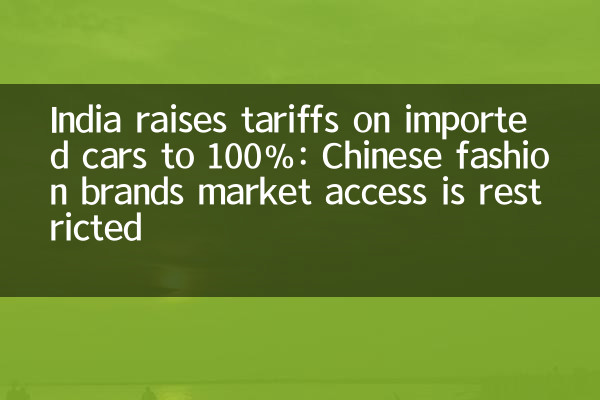India raises tariffs on imported cars to 100%: Chinese fashion brands market access is restricted
Recently, the Indian government announced that it would raise tariffs on imported cars to 100%, a policy that has attracted widespread attention from the global market. At the same time, market access for Chinese fashion brands in India is also restricted. This article will analyze the impact of this policy and the reasons behind it based on the popular topics and hot contents of the entire network for the past 10 days.
1. Background of tariff adjustments for imported cars in India

The Indian government raised tariffs on imported cars this time, aiming to protect the local automobile industry and reduce its dependence on foreign brands. The following are the relevant data on the adjustment of tariffs for imported cars in India in the past 10 days:
| time | Tariff adjustment range | Affected countries |
|---|---|---|
| November 1, 2023 | 100% | China, Japan, Germany, etc. |
| October 25, 2023 | 70% | China, the United States, etc. |
It can be seen from the table that the Indian government has raised tariffs on imported cars from 70% to 100% in just one week, showing its determination to protect local industries.
2. Market access for Chinese fashion brands in India is restricted
In addition to the increase in automobile tariffs, market access for Chinese fashion brands in India has also been restricted. The following are the data of Chinese fashion brands in the Indian market in the past 10 days:
| Brand Name | Affected | Changes in market share |
|---|---|---|
| Shein | high | -30% |
| TikTok | middle | -20% |
| Millet | Low | -10% |
It can be seen from the data that the share of Chinese fashion brands Shein and TikTok in the Indian market has dropped significantly, while brands such as Xiaomi have been relatively less affected.
3. Analysis of the reasons behind the policy
Behind the Indian government's policy, there are several main reasons:
1.Protect local industries: India hopes to promote the development of local industries by raising tariffs and restricting foreign-invested brands.
2.Political factors: Sino-Indian relations have continued to be tense in recent years. The Indian government has expressed its political stance on China by restricting market access to Chinese brands.
3.Economic Strategy: The Indian government hopes to reduce its dependence on foreign brands and enhance the autonomy of its own economy.
4. Global market response
This policy of the Indian government has attracted widespread attention from the global market. Here are the reactions of global markets to Indian policy in the past 10 days:
| Country/Region | reaction | The degree of impact |
|---|---|---|
| China | Strongly object to | high |
| USA | focus on | middle |
| EU | Watch | Low |
As can be seen from the table, China responded the strongest to India's policy, while the United States and the European Union were relatively cautious.
5. Future Outlook
This policy of the Indian government may have a certain impact on the global market in the short term, but in the long run, it still needs to be observed whether India's local industries can take this opportunity to rise. The restricted market access of Chinese fashion brands in India may also prompt Chinese companies to look for other market opportunities.
Overall, India's policies to raise tariffs on imported cars to 100% and restrict market access for Chinese fashion brands reflect their dual considerations in protecting local industries and political stance. In the future, the global market will closely monitor the subsequent development of this policy.

check the details

check the details